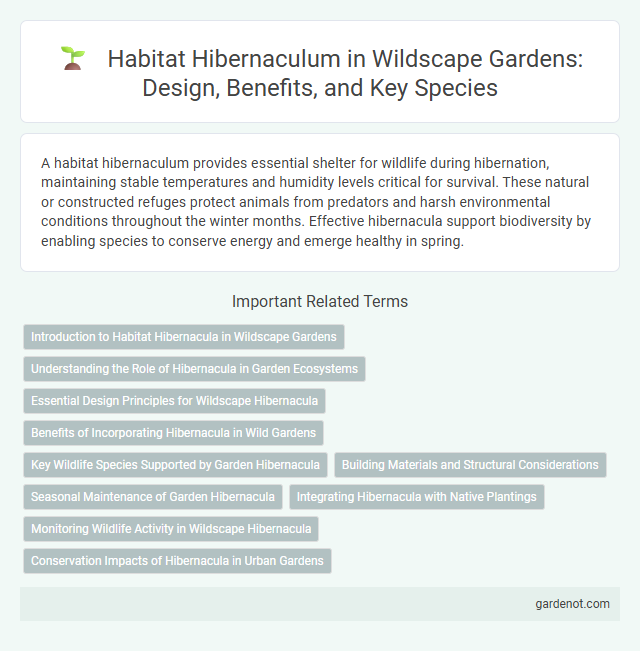A habitat hibernaculum provides essential shelter for wildlife during hibernation, maintaining stable temperatures and humidity levels critical for survival. These natural or constructed refuges protect animals from predators and harsh environmental conditions throughout the winter months. Effective hibernacula support biodiversity by enabling species to conserve energy and emerge healthy in spring.
Introduction to Habitat Hibernacula in Wildscape Gardens
Habitat hibernacula in Wildscape Gardens serve as essential refuges designed to support the natural hibernation behaviors of native wildlife such as amphibians, reptiles, and insects. These carefully constructed shelters replicate the protective conditions found in natural environments, promoting biodiversity and ecological balance within the garden. By providing safe overwintering sites, habitat hibernacula contribute significantly to the conservation efforts and enhance habitat resilience throughout seasonal changes.
Understanding the Role of Hibernacula in Garden Ecosystems
Hibernacula provide critical shelter for various wildlife, enabling species to survive cold seasons and maintain ecological balance within garden ecosystems. These specialized habitats support biodiversity by offering safe overwintering sites for amphibians, reptiles, and insects, ensuring their population stability. Incorporating hibernacula into garden design enhances resilience and promotes natural pest control by sustaining beneficial organisms year-round.
Essential Design Principles for Wildscape Hibernacula
Wildscape hibernacula must incorporate key design principles such as proper insulation, moisture control, and structural complexity to mimic natural shelter conditions and support species survival during dormancy. Ensuring stable temperature zones and protection from predators enhances the suitability for amphibians, reptiles, and invertebrates requiring overwintering habitat. Strategic placement within the wildscape, combined with native vegetation and non-invasive materials, promotes ecological integration and long-term functionality of the hibernaculum.
Benefits of Incorporating Hibernacula in Wild Gardens
Incorporating hibernacula in wild gardens provides essential overwintering shelters for amphibians, reptiles, and beneficial insects, promoting biodiversity and ecological balance. These microhabitats offer protection from harsh weather and predators, increasing survival rates during colder months. Integrating natural materials like logs, rocks, and leaf litter fosters habitat connectivity and supports local wildlife conservation efforts.
Key Wildlife Species Supported by Garden Hibernacula
Garden hibernacula provide essential overwintering habitats for key wildlife species such as hedgehogs, amphibians like frogs and newts, and various invertebrates including solitary bees and beetles. These structures offer shelter from harsh weather and predators, supporting biodiversity by maintaining stable populations during dormant periods. Incorporating diverse materials such as logs, leaf litter, and stones within the hibernaculum enhances habitat suitability for a wide range of species.
Building Materials and Structural Considerations
Habitat hibernacula require durable, insulated building materials like untreated wood, stone, and straw to provide stable microclimates essential for species like hedgehogs and amphibians. Structural considerations include creating dark, moist, and secure spaces with adequate ventilation to prevent mold while maintaining consistent humidity levels. Proper layering and compact design enhance thermal regulation and protect inhabitants from predators and harsh weather conditions.
Seasonal Maintenance of Garden Hibernacula
Seasonal maintenance of garden hibernacula involves clearing debris and ensuring shelter structures, such as log piles, rock crevices, and leaf litter, remain intact and dry to provide optimal overwintering conditions for amphibians, reptiles, and invertebrates. Regular inspection during autumn prepares the habitat for colder months by reinforcing insulation and preventing waterlogging, which is crucial for successful hibernation. Maintaining diverse microhabitats within wildscape gardens supports biodiversity and enhances the survival rates of hibernating species.
Integrating Hibernacula with Native Plantings
Integrating hibernacula with native plantings enhances the survival of overwintering wildlife by providing essential microhabitats and thermal insulation. Native plants support local biodiversity by offering food resources and shelter, creating a seamless transition into the hibernaculum environment. This approach promotes ecological balance, ensuring that amphibians, reptiles, and insects thrive during dormant seasons.
Monitoring Wildlife Activity in Wildscape Hibernacula
Monitoring wildlife activity in Wildscape hibernacula involves using motion-activated cameras and environmental sensors to track species occupancy and behavioral patterns during dormancy. Data collected on temperature, humidity, and animal movements helps optimize habitat conditions to support diverse hibernating fauna. Continuous observation enables early detection of disturbances, ensuring effective conservation management within these critical habitat refuges.
Conservation Impacts of Hibernacula in Urban Gardens
Hibernacula in urban gardens provide critical shelter for wildlife species during winter, supporting biodiversity by maintaining stable microclimates essential for hibernating animals like amphibians, reptiles, and insects. These structures help conserve local populations by mitigating habitat loss caused by urban development and climate change, enhancing ecosystem resilience. Effective integration of hibernacula within wildscapes boosts survival rates and genetic diversity, contributing significantly to urban conservation efforts.
Habitat hibernaculum Infographic

 gardenot.com
gardenot.com